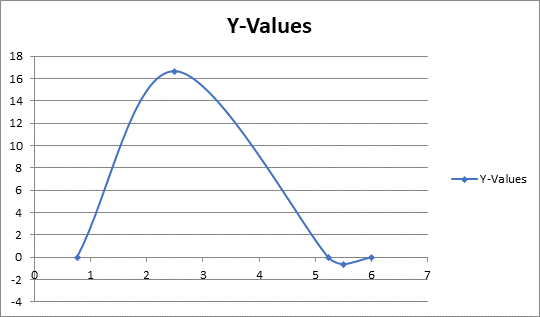
Concept explainers
a.
To use the zero or root feature of a graphing utility to approximate (accurate to the nearest thousands) the zeros of the function.
a.
Answer to Problem 102E
Explanation of Solution
Given: Given function is
Concept Used:
Zeros are the values for x for which function gives zero value.
Calculation: To graph the function calculates the following points of the graph.
| s | f(s) |
| 0.764 | 0 |
| 2.5 | 16.625 |
| 5.236 | 0 |
| 5.5 | -0.625 |
| 6 | 0 |
Graph the function on the above points

Where x- axis represents s and y -axis represents f(s).
b.
To find one of the exact zeros and use synthetic division to verify result.
b.
Answer to Problem 102E
s =6 an exact zero of the given polynomial function.
Explanation of Solution
Given: Given function is
Concept Used:
Synthetic division is used here.
Calculation:
s= 6 looks like an exact zero. Confirm with synthetic division.
Using the bottom row as coefficient of the resulting polynomial from dividing f by (s -6).
c.
To factor the polynomial completely..
c.
Answer to Problem 102E
The complete factorization is,
Explanation of Solution
Given: Given function is
Concept Used:
Use the
Calculation:
The complete factorization is,
Chapter 2 Solutions
Precalculus with Limits: A Graphing Approach
- I) For what value(s) of x does g(x) = -4? Separate multiple answers with commas as needed. J) Give the interval(s) of such that g(x) > 0. Use the union symbol between multiple intervals. K) Give the interval(s) of such that g(x) <0. Use the union symbol between multiple intervals.arrow_forwardneed help on Barrow_forward4. Use the properties of limits to help decide whether each limit exists. If a limit exists, fi lim (2x²-4x+5) a) x-4 b) lim 2 x²-16 x-4x+2x-8arrow_forward
- 7. The concentration of a drug in a patient's bloodstream h hours after it was injected is given by 0.17 h Ah= h²+2' Find and interpret lim A(h). Remember, the answers to word problems should always be given in a complete h→00 sentence, with proper units, in the context of the problem.arrow_forward#2arrow_forward2. We want to find the inverse of f(x) = (x+3)² a. On the graph at right, sketch f(x). (Hint: use what you know about transformations!) (2 points) b. What domain should we choose to get only the part of f (x) that is one- to-one and non-decreasing? Give your answer in inequality notation. (2 points) - c. Now use algebra to find f¯¹ (x). (2 points) -4- 3- 2 1 -4 -3 -2 -1 0 1 -1- -2- --3- -4 -N- 2 3 4arrow_forward
- 1. Suppose f(x) = 2 4 == x+3 and g(x) = ½-½. Find and fully simplify ƒ(g(x)). Be sure to show all x your work, write neatly so your work is easy to follow, and connect your expressions with equals signs. (4 points)arrow_forwardFind the ane sided limit lim 2 x+1-3x-3arrow_forward4 44 3+ 2+ -4-3 -2 -1 2 3 4 -2 -3. Find the values at X which the graph is discontinuous and categorize them.arrow_forward
 Calculus: Early TranscendentalsCalculusISBN:9781285741550Author:James StewartPublisher:Cengage Learning
Calculus: Early TranscendentalsCalculusISBN:9781285741550Author:James StewartPublisher:Cengage Learning Thomas' Calculus (14th Edition)CalculusISBN:9780134438986Author:Joel R. Hass, Christopher E. Heil, Maurice D. WeirPublisher:PEARSON
Thomas' Calculus (14th Edition)CalculusISBN:9780134438986Author:Joel R. Hass, Christopher E. Heil, Maurice D. WeirPublisher:PEARSON Calculus: Early Transcendentals (3rd Edition)CalculusISBN:9780134763644Author:William L. Briggs, Lyle Cochran, Bernard Gillett, Eric SchulzPublisher:PEARSON
Calculus: Early Transcendentals (3rd Edition)CalculusISBN:9780134763644Author:William L. Briggs, Lyle Cochran, Bernard Gillett, Eric SchulzPublisher:PEARSON Calculus: Early TranscendentalsCalculusISBN:9781319050740Author:Jon Rogawski, Colin Adams, Robert FranzosaPublisher:W. H. Freeman
Calculus: Early TranscendentalsCalculusISBN:9781319050740Author:Jon Rogawski, Colin Adams, Robert FranzosaPublisher:W. H. Freeman
 Calculus: Early Transcendental FunctionsCalculusISBN:9781337552516Author:Ron Larson, Bruce H. EdwardsPublisher:Cengage Learning
Calculus: Early Transcendental FunctionsCalculusISBN:9781337552516Author:Ron Larson, Bruce H. EdwardsPublisher:Cengage Learning





